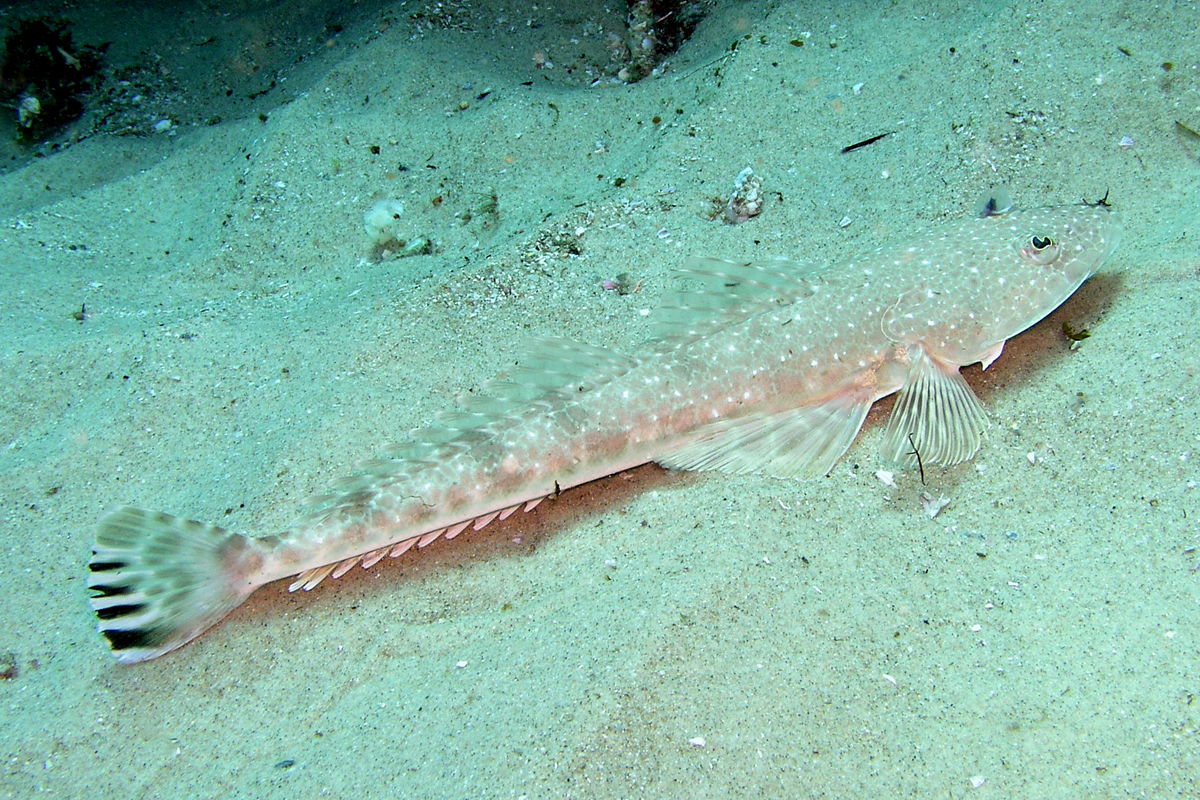- Classification
- ACTINOPTERYGII
- SCORPAENIFORMES
- PLATYCEPHALIDAE
- Platycephalus
- caeruleopunctatus
Bluespotted Flathead, Platycephalus caeruleopunctatus McCulloch 1922

A Bluespotted Flathead, Platycephalus caeruleopunctatus, at Seal Rocks, New South Wales, February 2007. Source: Sascha Schultz / iNaturalist.org. License: CC by Attribution-NonCommercial
Bluespotted Flathead, Platycephalus caeruleopunctatus McCulloch 1922
More Info
|
Distribution |
Endemic to estuarine, coastal and continental shelf waters of eastern Australia from the Calliope River (Queensland) to Lakes Entrance (Victoria); also off Lord Howe Island. Found on soft sediments, with juveniles preferring depths above 30 m and adults mostly in depths of 50-90 m. |
|
Features |
Dorsal fin VIII, 13-14; Anal fin 13-14; Pectoral fin 20; Pelvic fin I, 5; Lateral line scales (pored) 85-92. Body elongate, slightly depressed. Head large (length 31-33% SL), moderately depressed, with several pairs of prominent, spineless ridges, lower side bicarinate; eyes moderately large (16-23% HL), iris lappet a simple elongated lobe; mouth large, extending to about level with anterior margin of eye; teeth small, pointed on jaws, in a single patch on vomer and in a single row on each palatine, no enlarged canines; two strong preopercular spines at angle of preopercle, lower spine slightly longer than upper, a third very small posterior spine also present; first gill arch with 13-15 gill rakers on lower limb; interopercular flap present. Scales small, finely ctenoid, covering body and most of head behind eyes; lateral line scales similar to those adjacent on side, anteriormost one or two scales usually with a small spine or ridge. First dorsal fin spinous with short base, first spine very short, detached, following spines much longer. Second dorsal fin with moderately long base, anterior rays longest, slightly shorter than longest first dorsal-fin spine. Anal fin similar in shape, opposite and slightly longer-based than second dorsal fin. Caudal fin truncate. Pectoral fins moderate sized. Pelvic fins long, based below centre of pectoral fins. Swim bladder absent. |
|
Size |
Maximum length at least 60 cm; maximum weight at least 1.5 kg. |
|
Colour |
Colour variable; brownish dorsally with pale blue to whitish or red spots; a large dark blotch on underside of operculum; pale to whitish ventrally. Caudal-fin margin with 3 short, dark brownish stripes above a single dark blotch; pectoral and pelvic fins with small brown spots forming indistinct bands; anal fin whitish. |
|
Feeding |
Carnivore - feeds mostly on fishes and decapod crustaceans. Also consumes other crustaceans, polychaete worms and cephalopod molluscs. |
|
Biology |
Females grow larger than males. |
|
Fisheries |
Taken in significant numbers by prawn and fish trawls off New South Wales; commonly caught by anglers fishing offshore (including drift fishing for snapper, Pagrus auratus). |
|
Species Citation |
Platycephalus caeruleopunctatus McCulloch, 1922, Aust. Zool. 2(3): 120. Type locality: Port Jackson, New South Wales. |
|
Author |
CSIRO Marine & Atmospheric Research & Bray, D.J. 2024 |
|
Resources |
Bluespotted Flathead, Platycephalus caeruleopunctatus McCulloch 1922
References
Barnes, L.M., C.A. Gray & J.E. Williamson. 2011. Divergence of the growth characteristics and longevity of coexisting Platycephalidae (Pisces). Marine and Freshwater Research 62(11) 1308-1317. http://dx.doi.org/10.1071/MF11045
Barnes, L.M., Leclerc, M., Gray, C.A., & Williamson, J.E. 2011. Dietary niche differentiation of five sympatric species of Platycephalidae. Environmental Biology of Fishes 90: 429–441.
Coleman, N. 1980. Australian Sea Fishes South of 30ºS. Lane Cove, NSW : Doubleday Australia Pty Ltd 309 pp.
Coleman, N. & Mobley, M. 1984. Diets of commercially exploited fish from Bass Strait and adjacent Victorian waters, southeastern Australia. Australian Journal of Marine and Freshwater Research 35(5): 549-560. https://doi.org/10.1071/MF9840549
Fetterplace, L.C., Davis, A.R., Neilson, J.M., Taylor, M.D. & Knott, N.A. (2016). Active acoustic tracking suggests that soft sediment fishes can show site attachment: a preliminary assessment of the movement patterns of the blue-spotted flathead (Platycephalus caeruleopunctatus). Animal Biotelemetry 4: 15. Open access http://dx.doi.org/10.1186/s40317-016-0107-6
Grant, E.M. 2002. Guide to Fishes. Redcliffe : EM Grant Pty Ltd 880 pp.
Hutchins, B. & Swainston, R. 1986. Sea Fishes of Southern Australia. Swainston Publishing, Perth. 179 pp.
Kuiter, R.H. 1993. Coastal Fishes of South-eastern Australia. Bathurst : Crawford House Press 437 pp.
Imamura, H. 2006. Rediagnosis of the marbled flathead, Platycephalus marmoratus (Actinopterygii: Teleostei: Platycephalidae), with comments on the composition of the type series. Species Diversity 11: 295-306.
Prokop, F. 2002. Australian Fish Guide. Croydon South, Victoria : Australian Fishing Network 256 pp.
Roughley, T.C. 1957. Fish and Fisheries of Australia. Sydney : Angus & Robertson 341 pp. (p. 135, as Trudis caeruleopunctatus)
Rowling K, Hegarty A, Ives M. 2010. Bluespotted flathead (Playtcephalus caeruleopunctatus). In status of fisheries resources in NSW 2008/09, NSW Industry & Investment, Cronulla, p. 47–49.
Walker, T.I. 1982. Effects of length and locality on the mercury content of blacklip abalone, Notohaliotis ruber (Leach), blue mussel, Mytilus edulis planulatus (Lamarck), sand flathead, Platycephalus bassensis Cuvier & Valenciennes, and long-nosed flathead, Platycephalus caeruleopunctatus (McCulloch), from Port Phillip Bay, Victoria. Australian Journal of Marine and Freshwater Research 33(3): 553-560.
Whitley, G.P. 1931. Studies in ichthyology. No. 5. Records of the Australian Museum 18(4): 138-160.
Yearsley, G.K., Last, P.R. & Ward, R.D. 2001. Australian Seafood Handbook: an identification guide to domestic species. FRDC / CSIRO Marine Research, 469 pp.










